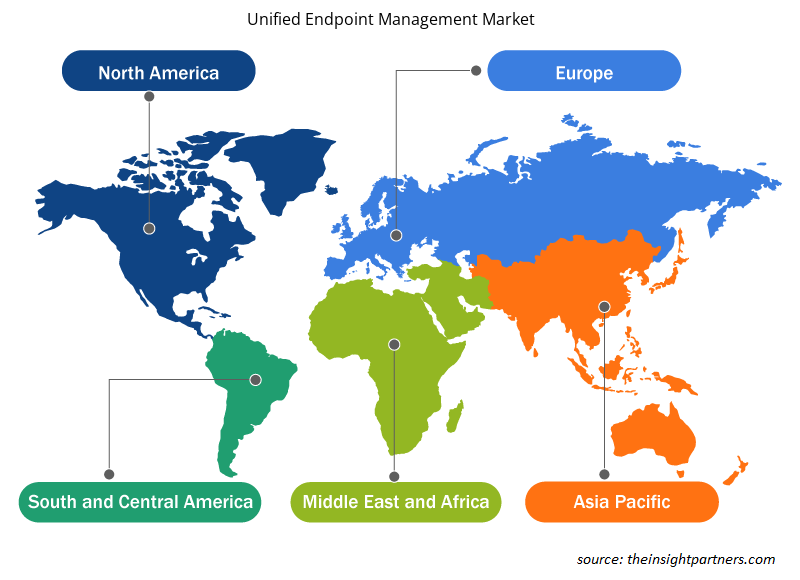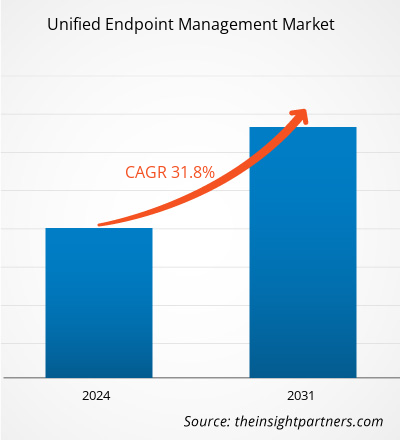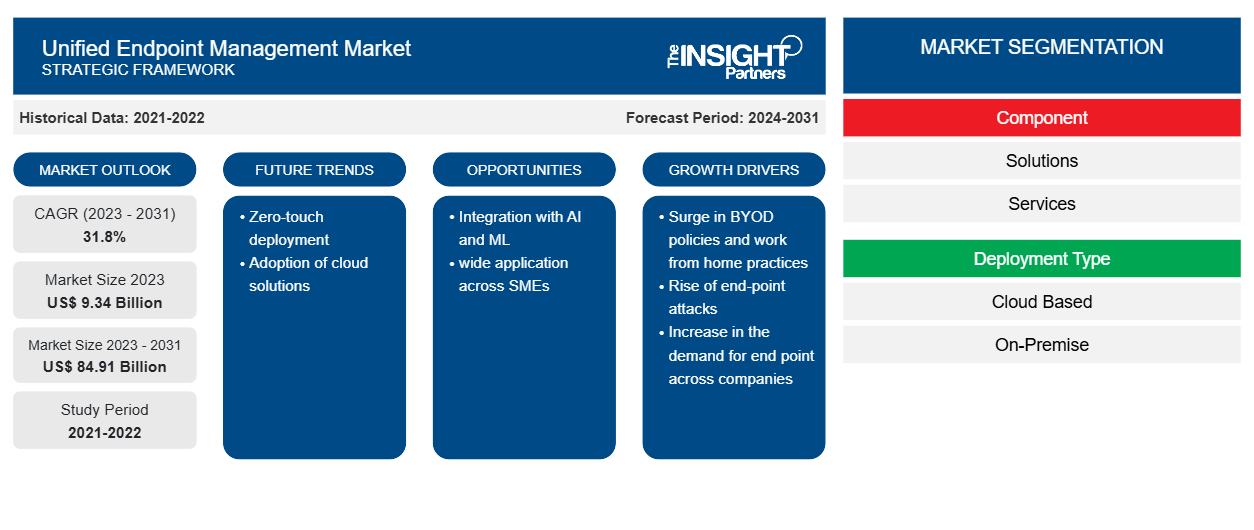من المتوقع أن يصل حجم سوق إدارة نقاط النهاية الموحدة إلى 84.91 مليار دولار أمريكي بحلول عام 2031 من 9.34 مليار دولار أمريكي في عام 2023. ومن المتوقع أن يسجل السوق معدل نمو سنوي مركب بنسبة 31.8٪ خلال الفترة 2023-2031. ومن المرجح أن يؤدي نشر الحلول بدون لمس وتبني الحلول السحابية عبر المؤسسات إلى ظهور اتجاهات جديدة في السوق.
تحليل سوق إدارة نقطة النهاية الموحدة
إن الطلب المتزايد على الأمن العالي والإدارة الفعّالة لنقاط النهاية والاتجاه المتزايد نحو القوى العاملة المتنقلة يدفعان إلى تبني حلول إدارة نقاط النهاية الموحدة عبر المؤسسات ذات الأحجام المختلفة. ومع الاتجاه المتزايد نحو الرقمنة وأماكن العمل الذكية والأتمتة، من المتوقع أن يرتفع الطلب على حلول إدارة نقاط النهاية الموحدة بسرعة في السنوات القادمة.
لقد أدى التقدم في تكنولوجيا المعلومات والتطبيقات الرقمية إلى زيادة موارد تكنولوجيا المعلومات في جميع أنحاء العالم. واستنادًا إلى تقرير صادر عن شركة سيسكو، بحلول نهاية عام 2021، سيكون هناك أكثر من 27.1 مليار جهاز متصل بالإنترنت. تتبنى الشركات بشكل متزايد نماذج متطورة لتلبية متطلبات الأجهزة لأنظمة التشغيل المحدثة مثل Windows 10 وChromeOS. مع الاستخدام المتزايد لنقاط النهاية مثل أجهزة الكمبيوتر المحمولة والأجهزة اللوحية والهواتف المحمولة وأجهزة الكمبيوتر المكتبية في الشركات، تزداد الحاجة إلى إدارة هذه النقاط النهائية من منصة واحدة، مما يؤدي إلى زيادة الطلب على الحلول الموحدة. يعد الاتجاه المتزايد لتطبيق السياسات التي تسمح للأجهزة الشخصية بالوصول إلى بيانات الشركة عاملاً آخر يدفع السوق.
نظرة عامة على سوق إدارة نقطة النهاية الموحدة
تتيح أدوات إدارة نقاط النهاية الموحدة (UEM) التي تقدمها شركات مختلفة للعملاء إدارة وتأمين جميع الخوادم والأجهزة ونقاط النهاية في المؤسسة من وحدة تحكم موحدة. إنها أيضًا مزيج من العديد من الحلول مثل إدارة التنقل المؤسسي وإدارة المحتوى المحمول وإدارة تطبيقات الهاتف المحمول وإدارة الأجهزة المحمولة وإدارة العميل. تغطي حلول إدارة نقاط النهاية الموحدة منصات مختلفة - مثل Windows وmacOS وiOS وAndroid وWear OS - عبر أجهزة مختلفة، بما في ذلك أجهزة الكمبيوتر المكتبية وأجهزة الكمبيوتر المحمولة والهواتف الذكية والأجهزة اللوحية والأجهزة القابلة للارتداء. تدعم هذه الحلول جميع حالات استخدام التنقل في المؤسسات، من الأجهزة المملوكة للشركات أو المصممة لهذا الغرض أو المشتركة إلى أجهزة BYOD. تشمل الفوائد الرئيسية لحلول إدارة نقاط النهاية الموحدة إدارة نقاط النهاية وإدارة ملف تعريف المستخدم ولوحات المعلومات وإعداد التقارير وإدارة الأجهزة المحمولة والتصحيح وأمان نقاط النهاية. ونظرًا لجميع الميزات والفوائد، أصبحت هذه الحلول والخدمات ذات الصلة شائعة بشكل متزايد بين صناعات تكنولوجيا المعلومات والاتصالات والرعاية الصحية والخدمات المصرفية والمالية والتأمين والحكومة وتجارة التجزئة وغيرها من صناعات المستخدم النهائي.
قم بتخصيص هذا التقرير ليناسب متطلباتك
ستحصل على تخصيص لأي تقرير - مجانًا - بما في ذلك أجزاء من هذا التقرير، أو تحليل على مستوى الدولة، وحزمة بيانات Excel، بالإضافة إلى الاستفادة من العروض والخصومات الرائعة للشركات الناشئة والجامعات
-
احصل على أهم اتجاهات السوق الرئيسية لهذا التقرير.ستتضمن هذه العينة المجانية تحليلاً للبيانات، بدءًا من اتجاهات السوق وحتى التقديرات والتوقعات.
محركات وفرص سوق إدارة نقطة النهاية الموحدة
ارتفاع حاد في سياسات إحضار الأجهزة الشخصية إلى العمل وممارسات العمل من المنزل
أدى ظهور جائحة كوفيد-19 إلى زيادة تبني نموذج العمل من المنزل، مما أدى إلى زيادة سياسات BYOD عبر مختلف المنظمات. يسمح BYOD للموظفين باستخدام الأجهزة الشخصية مثل الأجهزة اللوحية وأجهزة الكمبيوتر والهواتف الذكية للوصول إلى بيانات الشركة السرية والموارد والتطبيقات. وفقًا لتقرير Cybersecurity Insiders 2021، يستخدم 82٪ من المنظمات BYOD. وجد استطلاع أجراه 271 متخصصًا في الأمن السيبراني أن 70٪ من المنظمات لديها موظفون يحضرون أجهزتهم الخاصة إلى مكان العمل. ينطبق BYOD أيضًا على المقاولين (26٪ من المنظمات) والشركاء (21٪) والعملاء (18٪) والموردين (14٪). أيضًا، وفقًا لـ Jamf، في يوليو 2023، كان حوالي 75٪ من الأشخاص يستخدمون الأجهزة الشخصية للعمل المكتبي، مما أدى إلى زيادة الإنتاجية بنسبة 34٪؛ أيضًا، يمكن للمؤسسات توفير ما يقرب من 250 دولارًا أمريكيًا لكل موظف من خلال سياسة BYOD بالإضافة إلى المنح الدراسية. تساعد إدارة نقاط النهاية الموحدة في إدارة سياسات BYOD الخاصة بالمؤسسات وتوفر تدابير أمنية قوية مثل التشفير وضوابط الوصول الآمن، والتي تعد ضرورية لحماية بيانات الشركة على الأجهزة الشخصية. علاوة على ذلك، تضم أماكن العمل مزيجًا من العاملين في المكاتب والهجينين والبعيدين الذين يستخدمون بشكل متزايد أجهزتهم الشخصية للعمل من أي مكان. على سبيل المثال، اعتبارًا من ديسمبر 2022، وفقًا لـ "المعهد الوطني للمعايير والتكنولوجيا"، سمحت أكثر من 95٪ من المؤسسات للموظفين باستخدام أجهزتهم الخاصة للعمل من المنزل. أيضًا، وفقًا لـ Finance Online، أدى جائحة COVID-19 إلى قيام 85٪ من الشركات بتنفيذ سياسات BYOD. يفرض التنفيذ المتزايد لـ BYOD ضغوطًا على المؤسسات لمراقبة العمل عن بُعد للموظفين بشكل عام مع زيادة تنوع الأجهزة التي تصل إلى شبكات الشركات. توفر حلول إدارة نقاط النهاية الموحدة إدارة مركزية لجميع نقاط النهاية. وبالتالي، فإن الارتفاع في سياسات BYOD وممارسات العمل من المنزل يعزز الطلب على حلول إدارة نقاط النهاية الموحدة، مما يغذي نمو السوق.
التكامل مع الذكاء الاصطناعي والتعلم الآلي
تغير التقنيات المتقدمة بسرعة الطريقة التي يعمل بها قطاع تكنولوجيا المعلومات. تستخدم حلول إدارة نقاط النهاية الموحدة قوة الذكاء الاصطناعي وتكاملات التعلم الآلي لتوسيع استراتيجية الأمان الشاملة من خلال التحليلات السياقية والرؤى العميقة. باستخدام منهجيات متطورة، تتمكن فرق الأمان من تلقي اقتراحات بشأن التنبيهات وسياسات الصناعة والتهديدات الضارة وما إلى ذلك، مما يساعد في تعزيز الإنتاجية وتأمين بيئتها. يوفر الأمان القائم على التعلم الآلي بنية ثقة صفرية تستخدم تفويضًا فعالًا متعدد العوامل وغير ذلك من المصادقة والتشفير والتحليلات وحقوق مستوى نظام الملفات لمنع فقدان البيانات المهمة. علاوة على ذلك، من خلال فرض قواعد الوصول الديناميكية بناءً على أجهزة المستخدم وهويته وسياقه، من الممكن ضمان أن التطبيقات والمستخدمين المصرح لهم فقط يمكنهم الوصول إلى سطح الحماية.
تقوم معظم شركات إدارة نقاط النهاية الموحدة بدمج الذكاء الاصطناعي والتعلم الآلي في خطوط منتجاتها لتعزيز قيمتها وتمييز عروضها. توفر إدارة نقاط النهاية المتكاملة القائمة على الذكاء الاصطناعي نهجًا واسع النطاق لإدارة الأجهزة يمكنه تحسين الأمان. من خلال الاستفادة من خوارزميات الذكاء الاصطناعي لأتمتة العديد من المهام المرتبطة بإدارة أجهزة نقاط النهاية، يمكن للمؤسسات تقليل مخاطر انتهاكات الأمان. علاوة على ذلك، من خلال توفير رؤى في الوقت الفعلي حول صحة الجهاز وأنماط الاستخدام، يمكن لإدارة نقاط النهاية الموحدة القائمة على الذكاء الاصطناعي مساعدة المؤسسات على تحديد أولويات المشكلات واتخاذ الإجراءات قبل أن تصبح مشكلات كبيرة. أيضًا، تقوم العديد من الشركات بدمج الذكاء الاصطناعي والتعلم الآلي مع إدارة نقاط النهاية الموحدة، بما في ذلك بلاك بيري. وبالتالي، من المرجح أن يؤدي دمج الذكاء الاصطناعي والتعلم الآلي مع حلول إدارة نقاط النهاية الموحدة إلى خلق فرص جديدة لنمو السوق خلال فترة التنبؤ.
تقرير تحليل تجزئة سوق إدارة نقطة النهاية الموحدة
القطاعات الرئيسية التي ساهمت في استخلاص تحليل سوق إدارة نقطة النهاية الموحدة هيالمكون، والنشر، والمنصة، وحجم المنظمة، والمستخدم النهائي، والجغرافيا.
- بناءً على المكون، ينقسم السوق إلى حلول وخدمات. سيطر قطاع الحلول على السوق في عام 2023.
- من خلال النشر، ينقسم سوق إدارة نقاط النهاية الموحدة إلى قسمين: قسم قائم على السحابة وقسم محلي. وقد هيمن قطاع السحابة على السوق في عام 2023.
- من حيث المنصة، ينقسم سوق إدارة نقطة النهاية الموحدة إلى سطح المكتب والهواتف المحمولة. وقد استحوذ قطاع سطح المكتب على حصة أكبر من السوق في عام 2023.
- من حيث حجم المنظمة، ينقسم سوق إدارة نقطة النهاية الموحدة إلى الشركات الصغيرة والمتوسطة الحجم والشركات الكبيرة. وقد هيمن قطاع الشركات الكبيرة على السوق في عام 2023.
- من حيث المستخدم النهائي، يتم تقسيم السوق إلى BFSI وIT وTECOM والرعاية الصحية والسيارات والتصنيع والتجزئة وغيرها. هيمن قطاع IT وTECOM على السوق في عام 2023.
تحليل حصة سوق إدارة نقطة النهاية الموحدة حسب المنطقة الجغرافية
تم تقسيم سوق إدارة نقطة النهاية الموحدة إلى خمس مناطق رئيسية: أمريكا الشمالية وأوروبا وآسيا والمحيط الهادئ (APAC) والشرق الأوسط وأفريقيا (MEA) وأمريكا الجنوبية والوسطى. سيطرت أمريكا الشمالية على السوق في عام 2023، تليها أوروبا ومنطقة آسيا والمحيط الهادئ.
يشهد سوق إدارة نقاط النهاية الموحدة في أمريكا الشمالية نموًا كبيرًا بسبب زيادة الاستثمار من قبل الشركات في التقنيات المتقدمة لتبسيط عملياتها. بالإضافة إلى ذلك، فإن وجود عدد كبير من بائعي إدارة نقاط النهاية الموحدة وجهودهم المستمرة لتوفير حلول الأمان مع تقديم قدرات إدارة نقاط النهاية عالية الجودة يغذي نمو السوق في أمريكا الشمالية. علاوة على ذلك، يلعب التوافر المبكر وتبني أدوات الأمان الرقمية في جميع أنحاء المنطقة دورًا رئيسيًا في تعزيز تبني حلول إدارة نقاط النهاية الموحدة.
رؤى إقليمية حول سوق إدارة نقطة النهاية الموحدة
لقد قام المحللون في Insight Partners بشرح الاتجاهات والعوامل الإقليمية المؤثرة على سوق إدارة نقاط النهاية الموحدة طوال فترة التوقعات بشكل شامل. يناقش هذا القسم أيضًا قطاعات سوق إدارة نقاط النهاية الموحدة والجغرافيا في جميع أنحاء أمريكا الشمالية وأوروبا ومنطقة آسيا والمحيط الهادئ والشرق الأوسط وأفريقيا وأمريكا الجنوبية والوسطى.

- احصل على البيانات الإقليمية المحددة لسوق إدارة نقطة النهاية الموحدة
نطاق تقرير سوق إدارة نقطة النهاية الموحدة
| سمة التقرير | تفاصيل |
|---|---|
| حجم السوق في عام 2023 | 9.34 مليار دولار أمريكي |
| حجم السوق بحلول عام 2031 | 84.91 مليار دولار أمريكي |
| معدل النمو السنوي المركب العالمي (2023 - 2031) | 31.8% |
| البيانات التاريخية | 2021-2022 |
| فترة التنبؤ | 2024-2031 |
| القطاعات المغطاة |
حسب المكون
|
| المناطق والدول المغطاة |
أمريكا الشمالية
|
| قادة السوق وملفات تعريف الشركات الرئيسية |
|
كثافة اللاعبين في سوق إدارة نقاط النهاية الموحدة: فهم تأثيرها على ديناميكيات الأعمال
يشهد سوق إدارة نقاط النهاية الموحدة نموًا سريعًا، مدفوعًا بالطلب المتزايد من المستخدم النهائي بسبب عوامل مثل تفضيلات المستهلكين المتطورة والتقدم التكنولوجي والوعي المتزايد بفوائد المنتج. ومع ارتفاع الطلب، تعمل الشركات على توسيع عروضها والابتكار لتلبية احتياجات المستهلكين والاستفادة من الاتجاهات الناشئة، مما يؤدي إلى زيادة نمو السوق.
تشير كثافة اللاعبين في السوق إلى توزيع الشركات أو المؤسسات العاملة في سوق أو صناعة معينة. وهي تشير إلى عدد المنافسين (اللاعبين في السوق) الموجودين في مساحة سوق معينة نسبة إلى حجمها أو قيمتها السوقية الإجمالية.
الشركات الرئيسية العاملة في سوق إدارة نقطة النهاية الموحدة هي:
- شركة 42جيرز لأنظمة التنقل المحدودة.
- شركة بلاك بيري المحدودة
- ماتريكس42 ايه جي
- شركة موبايل ايرون
- إيفانتي
- شركة سيتريكس سيستمز
إخلاء المسؤولية : الشركات المذكورة أعلاه ليست مرتبة بأي ترتيب معين.

- احصل على نظرة عامة على أهم اللاعبين الرئيسيين في سوق إدارة نقطة النهاية الموحدة
أخبار سوق إدارة نقطة النهاية الموحدة والتطورات الأخيرة
يتم تقييم سوق إدارة نقطة النهاية الموحدة من خلال جمع البيانات النوعية والكمية بعد البحث الأولي والثانوي، والذي يتضمن منشورات الشركات المهمة وبيانات الجمعيات وقواعد البيانات. فيما يلي بعض التطورات في سوق إدارة نقطة النهاية الموحدة:
- أعلنت شركة HCL Software، الشركة العالمية الرائدة في حلول برامج المؤسسات، عن إطلاق حلول BigFix Workspace وEnterprise، والتي تعمل على إحداث ثورة في إدارة نقاط النهاية وأتمتة الأمان للمؤسسات في جميع أنحاء العالم. مع التركيز على تحسين تجربة الموظف الرقمية وضمان الامتثال التنظيمي السلس، تعمل هذه العروض المبتكرة على إعادة تعريف الطريقة التي تتعامل بها الشركات مع إدارة نقاط النهاية في بيئة ديناميكية.
(المصدر: HCL Software، بيان صحفي، مارس 2024)
- أعلنت شركة BlackBerry Limited، الرائدة في إدارة الأجهزة المحمولة للمؤسسات، عن ابتكارين جديدين رئيسيين لإدارة نقاط النهاية الموحدة (UEM) - BlackBerry UEM في الحافة وBlackBerry UEM لإنترنت الأشياء.
(المصدر: BlackBerry Limited، بيان صحفي، أكتوبر 2023)
تقرير سوق إدارة نقطة النهاية الموحدة: التغطية والنتائج المتوقعة
يوفر "حجم سوق إدارة نقطة النهاية الموحدة والتوقعات (2021-2031)" تحليلاً مفصلاً للسوق يغطي المجالات المذكورة أدناه:
- حجم سوق إدارة نقطة النهاية الموحدة والتوقعات على المستويات العالمية والإقليمية والوطنية لجميع قطاعات السوق الرئيسية التي يغطيها النطاق
- اتجاهات سوق إدارة نقطة النهاية الموحدة بالإضافة إلى ديناميكيات السوق مثل المحركات والقيود والفرص الرئيسية
- تحليل مفصل لـ PEST و SWOT
- تحليل سوق إدارة نقطة النهاية الموحدة يغطي اتجاهات السوق الرئيسية والإطار العالمي والإقليمي والجهات الفاعلة الرئيسية واللوائح والتطورات الأخيرة في السوق
- تحليل المشهد الصناعي والمنافسة الذي يغطي تركيز السوق، وتحليل خريطة الحرارة، واللاعبين البارزين، والتطورات الأخيرة لسوق إدارة نقطة النهاية الموحدة
- ملفات تعريف الشركة التفصيلية
- التحليل التاريخي (سنتان)، سنة الأساس، التوقعات (7 سنوات) مع معدل النمو السنوي المركب
- تحليل PEST و SWOT
- حجم السوق والقيمة / الحجم - عالمي، إقليمي، بلد
- الصناعة والمنافسة
- مجموعة بيانات إكسل
التقارير الحديثة
تقارير ذات صلة
شهادات العملاء
سبب الشراء
- اتخاذ قرارات مدروسة
- فهم ديناميكيات السوق
- تحليل المنافسة
- رؤى العملاء
- توقعات السوق
- تخفيف المخاطر
- التخطيط الاستراتيجي
- مبررات الاستثمار
- تحديد الأسواق الناشئة
- تحسين استراتيجيات التسويق
- تعزيز الكفاءة التشغيلية
- مواكبة التوجهات التنظيمية























 احصل على عينة مجانية ل - سوق إدارة نقطة النهاية الموحدة
احصل على عينة مجانية ل - سوق إدارة نقطة النهاية الموحدة